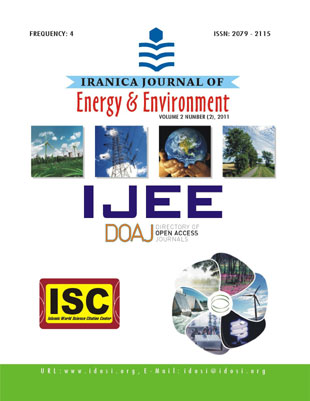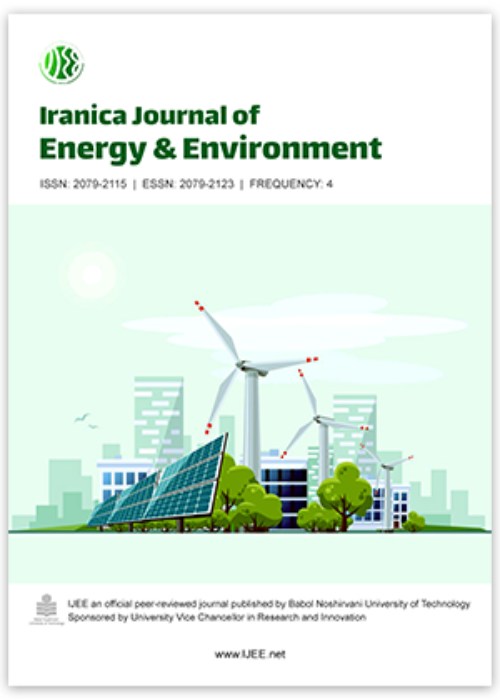فهرست مطالب

Iranica Journal of Energy & Environment
Volume:2 Issue: 2, Spring 2011
- تاریخ انتشار: 1390/05/01
- تعداد عناوین: 10
-
Impact of Climate Change in NigeriaPage 6
-
Page 104A cost structure is proposed for evaluating and improving the ecological-economic efficiency of baling sub-scheme units within solid waste management schemes that end with, for example, incineration for heat and power production. The methodology proposed employs the previously introduced WAste Managements’ Efficient Decision model (WAMED) and the COmpany STatistical BUSiness Tool for Environmental Recovery indicator (COSTBUSTER). The previously introduced equality principle and the Efficient Use of Resources for Optimal Production Economy (EUROPE) model are applied so to in monetary terms express the emissions in case of bale related fire (sol), pollutions from leachate (liq) and odour (g) at a scheme. Previously, the EUROPE model has been applied to residuals from producing industry, the construction sector and whole landfills. A case study presents the practical application of the proposed methodology. It is concluded that the presented novel methodology for evaluation and improvement of the ecological-economic efficiency of solid waste baling management schemes simultaneously decreases the negative impact on the environment and the health of the population, provides the foundation of an investment appraisal support tool for the implementation of solid waste management projects and enables comparative analysis of estimated, actual and prevented monetary damages from the implementation of baling plant units.Keywords: Solid waste management baling plants % Pollutions % COSTBUSTER model % The equality principle % The EUROPE model
-
Page 117In the most cases of the practical fermentation processes with filamentous microorganisms, direct monitoring of the cell morphology and biomass distribution in the culture medium is not easily possible. Use of a mathematical model is a suitable way to describe the substrate uptake and cell growth behavior of these microorganisms. Penicillium brevicompactum is one of the morphologically complex filamentous fungi with different structural forms. In this work, nutrient uptake and cell growth kinetics were investigated using Monod and Moser models through batch submerged fermentation in a bench-scale stirred tank bioreactor. The experimental data were fitted with both the Monod and the Moser kinetic with a regression value of 0.87. The maximum specific growth rate and Monad's half-saturation coefficient were determined as 0.04 hG1 and 9 g. LG1, respectively. In Moser case, the maximum specific growth rate and K were obtained as 0.06 hG and 6.8 g. LG, s 1 1 respectively. Thus, both Monod and Moser kinetic are considered to be partially applicable models to explain kinetics behavior of Penicillium brevicompactum in submerged batch bioreactor culture. Key words:Penicillium brevicompactum % Monod kinetic % Monod saturation constant % Moser kinetic % Specific growth rate % Submerged batch bioreactor
-
Page 122We investigated some geotechnical properties of soils of Port Harcourt in 2009 under three land use types, namely mechanically cleared land, on-going building constructions and fallow land. A combination of target and random soil survey techniques guided field studies. Five soil samples were collected in each land use, giving a total of 15 soil samples which were air-dried and sieved. These soil samples were subjected to routine laboratory analysis and resulting data were analyzed statistically using means and correlation analysis. Soils were sandy, of slight to neutral acidity (pH = 5.9-7.6). Disturbed soils were older (silt-clay ratio= 0.13- water 0.50) when compared with fallow having a mean value of 2.1. Plasticity index values were low (< 35%) and differed due to the land use: 11.63% (building site), 12.29% (mechanically cleared land) and 14.57% (fallow). There was low colloidal activity: 0.36 (building site), 0.40 (fallow) and 0.41 (mechanically cleared land). Highest recorded maximum dry density was found in building site (2.03 Mg mG3), while 24.87% optimum moisture content was obtained in fallow soils. Plasticity index showed good relationships with moisture, clay and colloidal activity in the study sites.Keywords: Atterberg limits % Clay activity % Land use % Tropics
-
Page 128Total suspended particulates (TSPs) in ambient air of four cities of Pakistan were collected using a high volume sampling technique for subsequent heavy metal analysis. The sampling was conducted for 24 hours and the concentration of TSPs ranged 568-2074, 1191-3976, 1133-4400 and 112 280 μg/m3 for Islamabad, Gujranwala, Faisalabad and Bahwalnagar, respectively. The level of TSP contamination was very high in ambient air of two big industrial cities, Gujranwala and Faisalabad. TSPs were also analyzed for Cd, Pb and Zn using flame atomic absorption spectrometry (FAAS) following digestion using a mixture of analytical grade nitric acid and hydrochloric acid. Compared to other metals, concentration of Cd was slightly high (around 325 ng/m3) in the samples of Gujranwala and Faisalabad. Overall, the order of metal concentrations were Cd > Pb > Zn.Keywords: Total suspended particles % Particulate heavy metals % Cadmium % Lead % Zinc
-
Page 133Groundwater is the most important natural resource required for drinking to many people around the world, especially in rural areas. The resource cannot be optimally used and sustained unless the quality of groundwater is assessed. Positioned in Enfidha City-in northeastern Tunisia, the watershed of El Khairat stretches geographically from 40.07° to 40.36° North latitude; and from 8.56° to 9.02° East Longitude. In this region, El Khairat aquifer is the most important groundwater aquiferous system which is considered a major source for drinking and irrigation. In Tunisia, since the quantity and the quality of water available for different uses is variable from one place to another, groundwater quality in El Khairat deep aquifer was evaluated for its suitability for drinking purposes. To this end, an attempt has been made for the first time in order to determine spatial distribution of groundwater quality parameters and to identify places with the best quality for drinking within the study area based on: (1) an integrated analysis of physical-chemical parameters, (2) use of Geographical Information System and (3) Water Quality Index calculation. The physico chemical results were compared to the standard guideline values as recommended by the World Health Organization (WHO) for drinking and public health in order to have an overview of the present groundwater quality. According to the overall assessment of the basin, almost all the parameters analyzed are above the desirable limits of WHO. Using GIS contouring methods with Arcview 3.2a, spatial distribution maps of pH, TDS, EC, TH, Cl, HCO, SO4, 3 NO3, Ca, Mg, Na and K, have been created. An interpolation technique, ordinary Inverse Distance Weighted (IDW), was used to obtain the spatial distribution of groundwater quality parameters. The spatial analysis of groundwater quality patterns of the study area shows that the TDS value increases from north-west to southeast following the general trend of the Khairat aquifer flow direction. The spatial distribution map of TH shows that a majority of the groundwater samples falls in the very hard category. WQI was used to assess the suitability of groundwater from the study area for human consumption. From the WQI assessment, over 82% of the water samples fall within the ‘‘Poor’’ and ‘‘Very poor’’ categories, suggesting that groundwater from the south-eastern of the El Khairat deep aquifer is unsuitable for drinking purposes.Keywords: Geographical Information System % Spatial analysis % Water Quality Index % El Khairat deep aquifer % Tunisia
-
Page 153The overall focus of the research work was to study the various factors that affect plume dilution and dispersion. Some of the factors that were studied include; the effects of mixing height, the effects of plume rise and the effects of terrain in addition to momentum and buoyancy on the overall dispersion of plume released from a stack of known effective height. Data on temperature versus altitude was collected using an infra - red thermometer at different height of a telecommunication mast under construction. The highest temperature for the month was noted and the validity of the recorded data was done using correlation analysis. Mathematical analysis was then employed to determine the mixing depth which represents the effective height of any stack that must be placed in such location in other to allow for complete dispersion/dilution of any form of pollutant released from any source. Result obtained shows that the effective height of stack that can be erected in such location that will allow for effective dispersion of any pollutants was shown to be 1700m. Any stack below this height will lead to ground level pollution. Also discussed in this research paper is the application of Gaussian Plume model in the evaluation/analysis of the horizontal dispersion of pollutants released from a height (h).Keywords: Plume Dispersion, Mixing Height, Momentum, Buoyancy, Gaussian Plume equation, Air quality
-
Page 161The effect of pig iron slag particles on soil physico-chemical, biological and certain soil enzyme properties was studied. Contamination of iron slag particles altered physico-chemical, biological and enzyme properties of soil. While soil pH increased slightly, electrical conductivity, carbon, potassium and phosphorus contents increased significantly in polluted soil. Contamination of soil with pig iron slag caused drastic reduction in microbial population. Similarly, enzyme activities such as dehydrogenase and protease were ceased three fold in polluted soil when compared to the control.Keywords: Pig iron slag % Physico_chemical % Biological properties % Soil enzymes
-
Page 181In India biomethanation in conventional biogas plants have been proposed as one of the appropriate alternative sources of energy which can counter the escalating demand of fossil fuels. The number of installation of biogas plants is increasing rapidly and the trend is expected to continue at least for the foreseeable future. Biogas plants like many other energy generating technologies are not absolutely free from environmental problems. Environmental impacts related to biomethanation may range from localized health effects due to air, water, soil and pathogenic contamination to global warming at the global scale. The probable health and environmental impacts of energy production in conventional biogas plants have not been fully understood or well documented. A comprehensive assessment seems essential to make this energy source more viable and sustainable. The current article discusses the various positive and negative environmental implications associated with biomethanation and also tries to highlight some mitigation options.Keywords: Conventional biogas plant % Greenhouse gases % Nitrate pollution % Global warming
-
Page 188The objective of the present study was determined on the concentration of seven important elements and chemical composition of the organic compound from Medlar’s fruit (Iran) using ICP AES and GC-MS techniques. The mineral content of samples was determined by standard addition method and RSDs lower than 3.75. The detection limits of the method for the 7 elements were 0.04-4 μglG1. In Medlar fruit, the concentration of Calcium with compare to K, Mg, Na, Fe, Zn and Cr was more. Fourteen organic compounds of the Medlar's fruit were characterized. The results have shown that the main fatty acid is linolelaidic acid with percentages of 24.01. The percentages of oleic acid and palmitic acid in this fruit were 11.45 and 6.97, respectively.Keywords: Medlar % Fatty Acids % GC_MS % Soxhlet Extraction % ICP_AES


